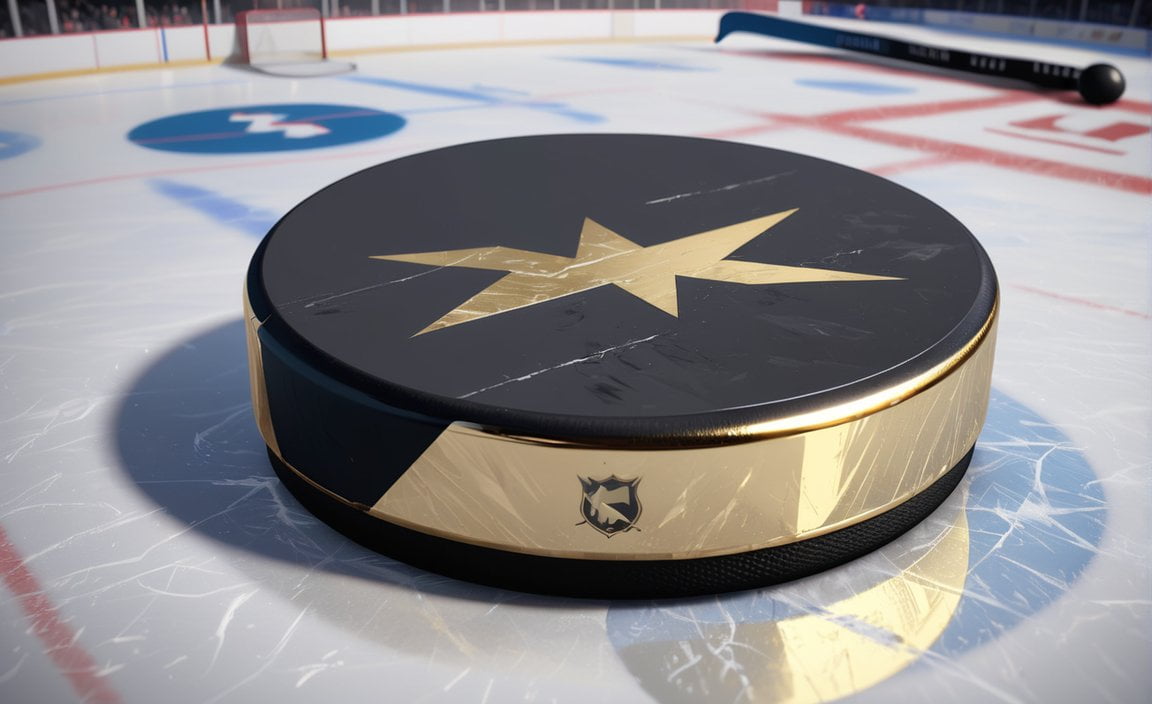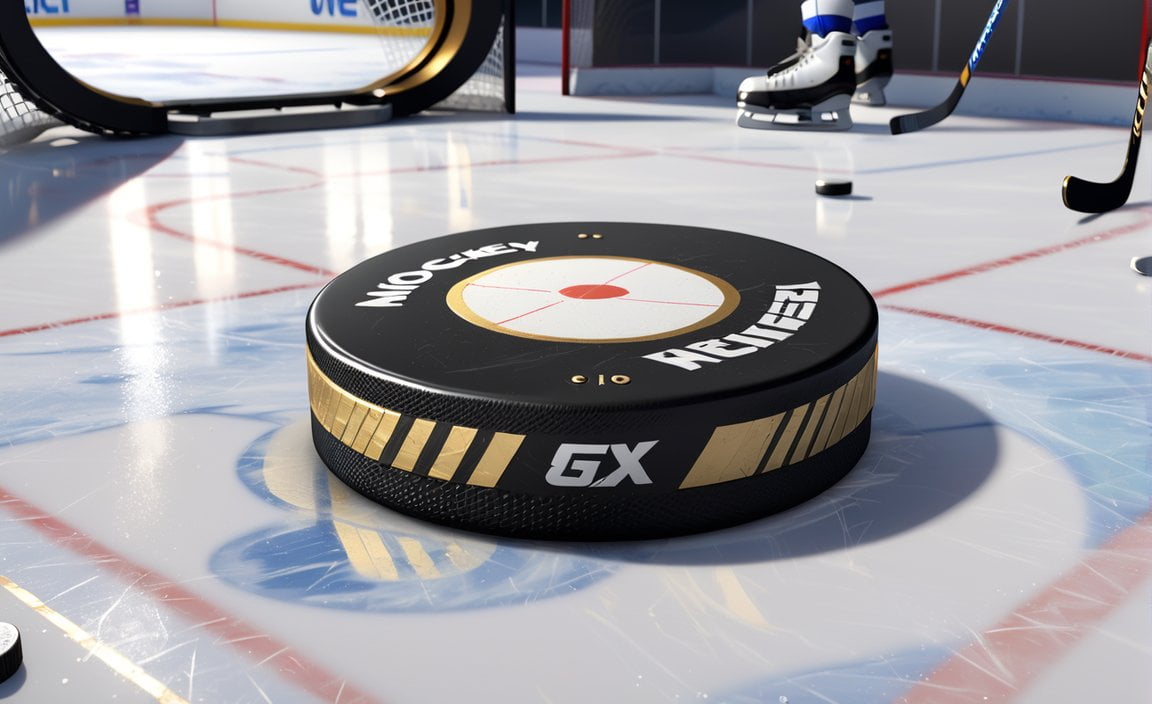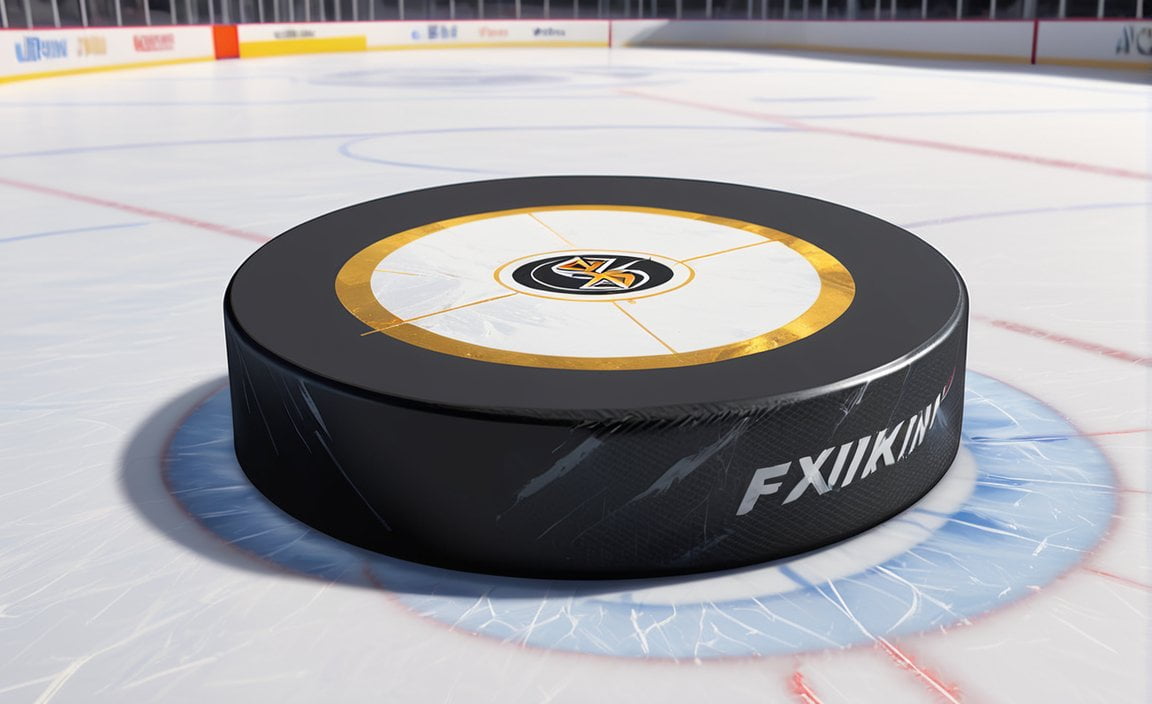Unraveling the Origins: What Was the First Hockey Puck Made Of? In the world of hockey, the puck is a fundamental component that has been at the center of the game for centuries. But have you ever wondered what material was used to create the very first hockey puck? As we delve into the annals of hockey history, we uncover a fascinating journey that takes us back to the roots of this beloved sport. Join us as we explore the evolution of the hockey puck and discover the surprising material behind its earliest incarnation.
Key Takeaways:

- The first round pucks made of vulcanized rubber were credited to the Victoria Hockey Club of Montreal in the 1880s, improving durability and predictability compared to previous cork pucks.
- A wooden block made of vulcanized rubber was used as a precursor to the modern puck in 1875 to prevent injuries to spectators.
- Art Ross designed and patented a new type of puck using vulcanized rubber in 1940, known as “the black biscuit.”
- Vulcanized rubber is used to make hockey pucks due to its resilience and durability, achieved through the process of vulcanization.
- The original hockey puck used in the first organized games in 1886 was made from a cut-down lacrosse ball, which was softer and bouncier than modern pucks.
Unraveling the Origins: What Was the First Hockey Puck Made Of?
In the thrilling world of hockey, the iconic puck holds great significance. As a seasoned sports journalist with a passion for uncovering the historical origins of sports equipment, I have set out on a mission to answer a question that has piqued the curiosity of hockey enthusiasts for centuries: What was the first hockey puck made of?
To delve into this intriguing topic, let’s begin our journey back in time to the late 19th century. The sport of hockey was rapidly gaining popularity, and players needed a reliable object to propel across the ice. While early iterations of the game often used a variety of items as pucks, including frozen cow dung and wooden blocks, it was the Victoria Hockey Club of Montreal that revolutionized the game by introducing the first round pucks made of vulcanized rubber in the 1880s.
With the adoption of vulcanized rubber, these new pucks provided several notable advantages over their predecessors. They were more durable, capable of withstanding the intense impact of the game without crumbling or shattering. Moreover, their vulcanized nature prevented water absorption, ensuring consistent performance regardless of the ice conditions. These rubber pucks also possessed more predictable bouncing properties, adding an exciting element to the game.
But, wait! Before the advent of these rubber pucks, there was an earlier appearance of a precursor to the modern puck. In 1875, players experimented with a wooden block made of vulcanized rubber. This unique design aimed to prevent the puck from rising and potentially injuring spectators, an issue that had previously plagued the game. Although effective in its purpose, this wooden block marked a stepping stone on the path to the round rubber puck we know today.
Fast-forwarding a few decades, we encounter another significant moment in the history of the hockey puck. Enter Art Ross, a prominent figure in hockey history. In 1940, Ross designed and patented a new type of puck, affectionately known as “the black biscuit.” This innovative creation retained the use of vulcanized rubber, but its distinct black color and improved smoothness garnered attention and popularity within the hockey community.
But what makes vulcanized rubber the material of choice for hockey pucks? Well, the process of vulcanization is key. By heating natural rubber with sulfur compounds under high pressure, the rubber undergoes a transformation. This heating and pressurization lead to cross-linking between polymer chains, resulting in a stronger, more resilient material. These properties make vulcanized rubber ideal for enduring the intense impact and rigorous demands of the game.
While pucks made from vulcanized rubber have become the staple in modern hockey, it’s interesting to note that the very first puck used in organized games back in 1886 had a different origin. In those early days, a cut-down lacrosse ball was repurposed as the puck. This makeshift solution provided a softer and bouncier puck, setting the stage for the evolution of this fundamental element in the world of hockey.
In conclusion, the first hockey puck made of vulcanized rubber, as credited to the Victoria Hockey Club of Montreal, revolutionized the game in the 1880s. These durable, non-absorbent, and predictably bouncing pucks paved the way for the modern hockey puck we know today. While variations and improvements have emerged over time, the use of vulcanized rubber remains a steadfast choice in manufacturing hockey pucks, ensuring resilience and durability on the ice.
So, the next time you watch hockey and witness the swift movements of the puck, take a moment to appreciate its origins and the ingenuity of those who shaped the game we know and love.
Here are some captivating links for you:
- Ryan Carson Curry age: Curious about Ryan Carson Curry’s age? Click here to find out more about this talented individual.
- What college did Serena Williams go to: Discover where Serena Williams pursued her education and honed her tennis skills by clicking here.
- Stephen Curry childhood: Dive into the fascinating world of Stephen Curry’s childhood and how it shaped the basketball superstar he is today.
- Is Wayne Gretzky still alive: Find out if Wayne Gretzky, the legendary ice hockey player, is still actively involved in the sports world by clicking here.
- Thor’s hammer Bryce Canyon: Be amazed by the natural wonder of Thor’s Hammer in Bryce Canyon and see breathtaking pictures by visiting this link.
- Steph Curry nationality: Get to know the nationality of the incredible Stephen Curry and explore the influences it has had on his basketball journey.
Feel free to click on any of the highlighted links to satisfy your curiosity!
The Evolution of Hockey Pucks: From Frozen Cow Dung to Vulcanized Rubber
The history of hockey pucks is a tale of innovation and adaptation. From its humble beginnings, this essential piece of equipment has evolved, contributing to the development and excitement of the game. In this article, we’ll uncover the intriguing story of the materials used for early hockey pucks, and how they have shaped the sport we know today.
The First Hockey Pucks: Frozen Cow Dung
Can you imagine playing hockey with frozen cow dung? Well, believe it or not, that’s how the earliest hockey pucks were made. During the early years of the sport, people used whatever materials were available, and during the winter months, frozen cow dung proved to be a suitable choice. These early pucks may not have been consistent in shape or texture, but they served their purpose on the ice.
Former NHL goaltender Corey Hirsch sheds light on this unconventional origin, stating that “the first pucks were probably made out of frozen cow dung.” While it may sound eccentric, the availability and moldability of this material made it an ideal option during the sport’s early days.
The Emergence of Vulcanized Rubber Pucks
In the late 1800s, the Victoria Hockey Club of Montreal introduced a game-changer in the form of round pucks made from vulcanized rubber. This remarkable invention marked a significant improvement over their predecessors. Vulcanized rubber pucks were more durable, didn’t absorb water, and offered a more predictable bounce. These advancements made the game faster, more consistent, and safer for players.
Vulcanized rubber is a stronger material created through the process of heating natural rubber with sulfur compounds under high pressure. This process results in cross-linking of polymer chains, enhancing the resilience and durability of the final product. By incorporating vulcanized rubber, hockey puck manufacturers created a game element that could withstand the demands of intense gameplay.
The Evolution of Modern Hockey Pucks
From the early days of frozen cow dung to the revolution of vulcanized rubber, the evolution of hockey pucks didn’t stop there. In the 1920s, the vulcanization process was further refined, leading to the production of rubber pucks that boasted improved consistency in bounce and glide. Although materials like plastic and metal were experimented with in the 1940s and 1950s, rubber remained the preferred choice for most players and leagues.
Today, hockey pucks continue to be made from vulcanized rubber. Standardization in size, weight, and performance ensures fairness and consistency across the sport. The durable and predictable nature of modern hockey pucks contributes to a faster and safer game.
Key Takeaways:
- The first hockey pucks were made from frozen cow dung, showcasing the sport’s humble origins.
- Vulcanized rubber pucks, introduced in the late 1800s, offered improved durability, water resistance, and predictability in bounce.
- Vulcanized rubber revolutionized the game, paving the way for faster and safer gameplay.
- The evolution of hockey pucks continued with refined vulcanization processes, resulting in rubber pucks that provided consistent bounce and glide.
- Despite experiments with plastic and metal, vulcanized rubber remains the preferred material due to its resilience and durability on the ice.
Sources:
1. Discover The Shocking Truth: What Was The Original Hockey Puck Made Of? – Ice Hockey Central
2. The Surprising History of Hockey Pucks: What Was Frozen to Create the First Pucks? – Ice Hockey Central
The Evolution of Hockey Puck Materials Over Time
The history of hockey is filled with interesting anecdotes and tales of the evolution of the sport. One vital element that has transformed over the years is the hockey puck. Join me on an exploration of the materials used to create the hockey puck and how it has evolved over time.
The Early Days: From Cow Dung to Wood
Believe it or not, the first hockey pucks were made from frozen cow dung. In the 19th century, outdoor hockey games in Canada often featured this unexpected choice of material. However, these dung pucks were far from ideal, as they quickly became messy and unpleasant.
To find an alternative, players turned to wooden disks cut from tree branches. Unfortunately, these wooden pucks lacked durability and frequently broke during intense gameplay. The search for a more suitable material was on.
Enter Rubber: The Game-Changing Material
In 1875, a significant development took place – the introduction of rubber pucks. Players began cutting up rubber balls, using the pieces to create a disk-like shape. The following year, these rubber discs acquired the name “puck.” This early version of rubber puck was not without its issues, but it marked an important step in the evolution of hockey equipment.
As the game grew in popularity, so did the demand for better and more durable pucks. In the early 1900s, hockey pucks began to be made by gluing two pieces of used tire rubber together. While this improved their durability, these pucks still had a tendency to split apart.
Art Ross: A Pioneer in Puck Design
Hockey Hall of Famer Art Ross played a crucial role in revolutionizing the design of hockey pucks. In 1940, he crafted pucks made of synthetic rubber, a departure from the traditional natural rubber. These synthetic rubber pucks featured textured edges, providing enhanced grip for players and increasing consistency throughout the game.
Ross’s innovative design improvements with synthetic rubber and textured edges not only extended the lifespan of pucks but also improved their performance on the ice. This marked a significant turning point in the development of hockey puck materials.
Key Takeaways:
- The first hockey pucks were made from frozen cow dung, followed by wooden disks cut from tree branches.
- Rubber pucks emerged in 1875, created by cutting up rubber balls into a disk-like shape.
- Two pieces of used tire rubber were glued together to improve durability in the early 1900s.
- Art Ross introduced pucks made of synthetic rubber in 1940, featuring textured edges for better grip and consistency.
- Synthetic rubber and enhanced design significantly improved the longevity and performance of hockey pucks.
Citation:
– The Surprising History of Hockey Pucks: What They Were First Made Of
– Discover The Shocking Truth: What Was The Original Hockey Puck Made Of
Discussion on the Possible Material of the First Hockey Puck
The origins of the beloved hockey puck have always been a topic of curiosity among sports enthusiasts. What material was used to create the first hockey puck? In this article, we will explore the intriguing history behind the earliest form of this fundamental element in the world of hockey. Join me as we dive deep into the annals of hockey to uncover the secrets behind the material of the first hockey puck.
Frozen Cow Manure and Early Pucks
One of the colorful theories suggests that the first hockey pucks were made from frozen cow manure. These makeshift pucks made of cow manure were easy to shape into a circular disc and were readily available on frozen ponds and lakes where early hockey games were played. However, it is important to note that there is no concrete evidence to support this claim. While it may make for an interesting anecdote, we must continue our exploration to discover more.
Evolution of Pucks: Wood, Rubber, and Plastic
As the game of hockey evolved, so did the materials used to create pucks. Over time, wood, rubber, and plastic became popular choices. Initially, wooden pucks were used, measuring around 1 inch thick by 3 inches in diameter. However, these early wood pucks had a tendency to chip, split, or break during play, making them less than ideal for prolonged use.
Art Ross and Synthetic Rubber Pucks
In the early 1900s, the legendary Art Ross made a significant contribution to the world of hockey pucks. Former Hockey Hall of Famer, Ross improved the design of the pucks by creating them out of synthetic rubber rather than natural rubber. This change in material made the pucks more durable and long-lasting, solving the issue of pucks breaking or becoming damaged during intense gameplay.
Key Takeaways:
- The first hockey pucks were rumored to be made of frozen cow manure, but no concrete evidence supports this claim.
- Over time, materials such as wood, rubber, and plastic were used to make hockey pucks.
- Early wood pucks had durability issues and were prone to chipping, splitting, or breaking during gameplay.
- Art Ross played a significant role in improving the design of hockey pucks by using synthetic rubber, increasing their durability and longevity.
Sources:
– [^1^]: The Surprising History of Hockey Pucks: What Was Frozen to Make the First Pucks
– [^3^]: What Was The First Hockey Puck Made Of?

FAQ
Q1: What was the first material used to create hockey pucks?
A1: The first hockey pucks were created using frozen cow dung, which was readily available on frozen ponds and lakes where early hockey games were played.
Q2: Why were early hockey pucks made from frozen cow dung?
A2: Early hockey pucks were made from frozen cow dung because it was easily shaped into circular discs and was accessible during the winter months when hockey games were played.
Q3: When did the first round pucks made of vulcanized rubber come into use?
A3: The first round pucks made of vulcanized rubber were introduced in the late 1800s by the Victoria Hockey Club of Montreal. These rubber pucks were more durable, didn’t absorb water, and had predictable bouncing properties.
Q4: What improvements did vulcanized rubber bring to hockey pucks?
A4: Vulcanized rubber made hockey pucks more durable, resistant to water absorption, and capable of more predictable bouncing. This advancement in material significantly enhanced the speed, consistency, and safety of the game.
Q5: Who played a significant role in improving the design of hockey pucks?
A5: Former Hockey Hall of Famer Art Ross played a significant role in improving the design of hockey pucks. In 1940, he introduced synthetic rubber pucks with textured edges, which improved stick grip and overall consistency during gameplay.
















